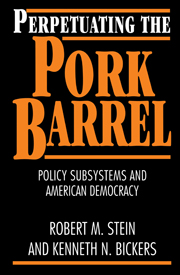Book contents
- Frontmatter
- Contents
- Tables and figures
- Acknowledgments
- PART I
- PART II
- PART III
- 4 A portfolio theory of policy subsystems
- 5 Policy subsystem adaptability and resilience in the Reagan period
- 6 PAC contributions and the distribution of domestic assistance programs
- 7 Congressional elections and the pork barrel
- PART IV
- APPENDIXES
- Notes
- Bibliography
- Index
6 - PAC contributions and the distribution of domestic assistance programs
Published online by Cambridge University Press: 05 June 2012
- Frontmatter
- Contents
- Tables and figures
- Acknowledgments
- PART I
- PART II
- PART III
- 4 A portfolio theory of policy subsystems
- 5 Policy subsystem adaptability and resilience in the Reagan period
- 6 PAC contributions and the distribution of domestic assistance programs
- 7 Congressional elections and the pork barrel
- PART IV
- APPENDIXES
- Notes
- Bibliography
- Index
Summary
In this chapter we examine the relationship between interest groups and legislators. Our focus is how this relationship promotes support for programs by legislators. A reason that legislators may support programs is that they may benefit from the activities of interest groups that have a stake in those programs, whether or not program benefits go to their districts. Interest group contributions may serve as the functional equivalent of programmatic benefits in enhancing the electoral fortunes of legislators. We precede first with a discussion of our own explanation for the interest group–legislator finance relationship and then proceed to a review of the literature on interest groups and their influence on policy decisions. This explanation should be viewed in terms of the larger set of relationships among actors within policy subsystems. As argued earlier, agencies and legislative committees play important roles in helping interest groups overcome their collective action problems. Data collected on interest group activity with respect to nine public laws passed during the 99th and 100th Congresses are used to examine these dynamics.
THE LEGISLATOR–INTEREST GROUP FINANCE RELATIONSHIP
To understand how interest groups might operate to supplement programmatic benefits to a district, we need to consider the set of relationships among actors in the policy subsystem. Our principal thesis is that policy subsystems and their main product, program portfolios, affect the goals and objectives of each actor in the subsystem. Legislators seek reelection through the electoral support of constituents.
- Type
- Chapter
- Information
- Perpetuating the Pork BarrelPolicy Subsystems and American Democracy, pp. 90 - 117Publisher: Cambridge University PressPrint publication year: 1995



